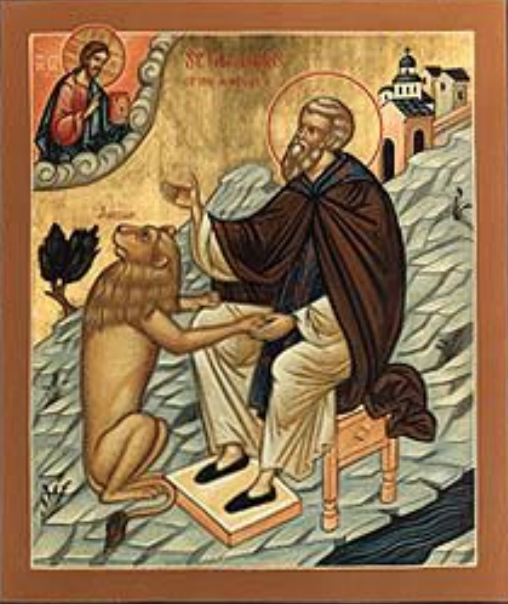Venerable Gerasimus of the Jordan
 “Father, you burned with heavenly love, preferring the harshness of the Jordan desert to all the delights of the world. Therefore, a wild beast served you until your death; he died in obedience and grief on your grave.” (Kontakion to St. Gerasimus) .
“Father, you burned with heavenly love, preferring the harshness of the Jordan desert to all the delights of the world. Therefore, a wild beast served you until your death; he died in obedience and grief on your grave.” (Kontakion to St. Gerasimus) .
The saying goes that March comes in like a lion and goes out like a lamb. And a lion figures prominently in the story of a Saint who is celebrated on March 17 on the Gregorian Calendar (which is March 4 on the Julian). It is St. Gerasimus of the Jordan – so called to differentiate him from another Gerasimus, the “walking Saint” who is the Patron of the Greek Island of Kephalonia. Gerasimus of the Jordan was born in the province of Lycia near the Mediterranean in the south of Asia Minor (today Turkey). He was an especially serious young man and was still quite youthful when he gave up the comfortable life in the home of his wealthy parents and went to pursue a monastic path in the desert of southern Egypt called the Thebaid because of its proximity to the ancient Egyptian capital city of Thebes. Having gained some maturity by his endeavours and the counsels of fellow desert dwellers, Gerasimus returned to his native Lycia. Later, about 450, he settled in the desert of the Jordan in Palestine where he remained for the rest of his life among other monks. The lives of these men of God were marked by strict asceticism.
Gerasimus himself ate practically nothing during the Great Fast, being nourished solely by the Eucharist. Gerasimus is popularly remembered for his friendship with a lion, whom his brother monks named Jordan, and who is depicted in his Icon. His story is similar to the one written in the 2nd century by Aulus Gellius about Androcles and the Lion, on which George Bernard Shaw based his delightful play which was made into a movie in 1952. One day Gerasimus encountered a lion which was in great pain because of a thorn stuck in its paw. When he removed the thorn, the lion adopted him, following him about like a dog and eating the bread and vegetables he gave it. It was given the job of guarding the monastery’s donkey as it grazed on the riverbanks. One day the donkey was taken by a traveling merchant who mistook it for one of his. When the lion returned without the donkey the monks assumed it had eaten its charge. The lion was then given the donkey’s job of carrying water which it fulfilled patiently and obediently. One day the merchant passed by with the donkey. The lion recognized it and rushed forward with a roar. The frightened merchant was happy to leave the donkey behind and go his way in peace. When the lion returned to the monastery leading his donkey companion upon the leash put on it by the merchant the monks realized that he had been wrongly accused and gave him the name Jordan. Jordan was never away from the monastery for long but during one of his absences his friend, Gerasimus, fell asleep in the Lord. When the lion returned the monks led it to the Saint’s grave. Jordan laid down on it and, with a final sorrowful roar, died on the grave of his friend and master. Such friendship with animals reminds us of the life of Paradise in the beginning - which we also await in the age to come as we proclaim in the Nicene Creed. May St. Gerasimus with his lion friend inspire us to seek to live in harmony with our environment – human and otherwise, and so imitate, as best we may, the life of the Paradise for which we long and which is our true home. Amen.

